Top 10 Most Commonly Asked Mulching Questions (plus some pro mulching tips!)
If you want to refresh your landscaping and give your entire property a facelift, there is no better way to do it than to add a fresh layer of mulch to your flowerbeds.
The crisp, clean, renewed look of a freshly mulched landscape satisfies any homeowner’s heart!
But if you aren’t an experienced mulcher, you probably have questions about mulch and how to apply it to your landscape.
Zimmerman Mulch put together this article to answer a few of your questions about mulch and mulching.
We hope the following information is helpful to you!
Let’s get started.
Table Of Contents
Top 10 Mulching FAQs
If you are new to landscaping, you probably have quite a few questions. We hope this article gives you a kickstart on understanding one of the most common landscaping materials–mulch!
Here are some of the most common questions people ask about mulch.
Tally ho!
1. What is the purpose of mulch?
Mulch looks fantastic on your property but serves more purposes than making things look pretty. Here are a few of the main functions mulch plays:
-
Suppresses weeds
Keeping those frustrating weeds from encroaching on your plants is a constant battle! You will constantly pull weeds on your hands and knees if you don't do something about them.
A thick layer of mulch acts as a barrier that starves the weeds of light and air and keeps them suppressed. Of course, mulch degrades over time so that weeds will pop up again, but mulch can effectively minimize your weed struggles.
-
Enriches the soil
Mulch gradually decomposes and wears out, and you have to replace it with a fresh layer. However, the old mulch still benefits your plants. As the mulch decomposes, it provides the soil with additional texture and nutrients that improve your soil's health.
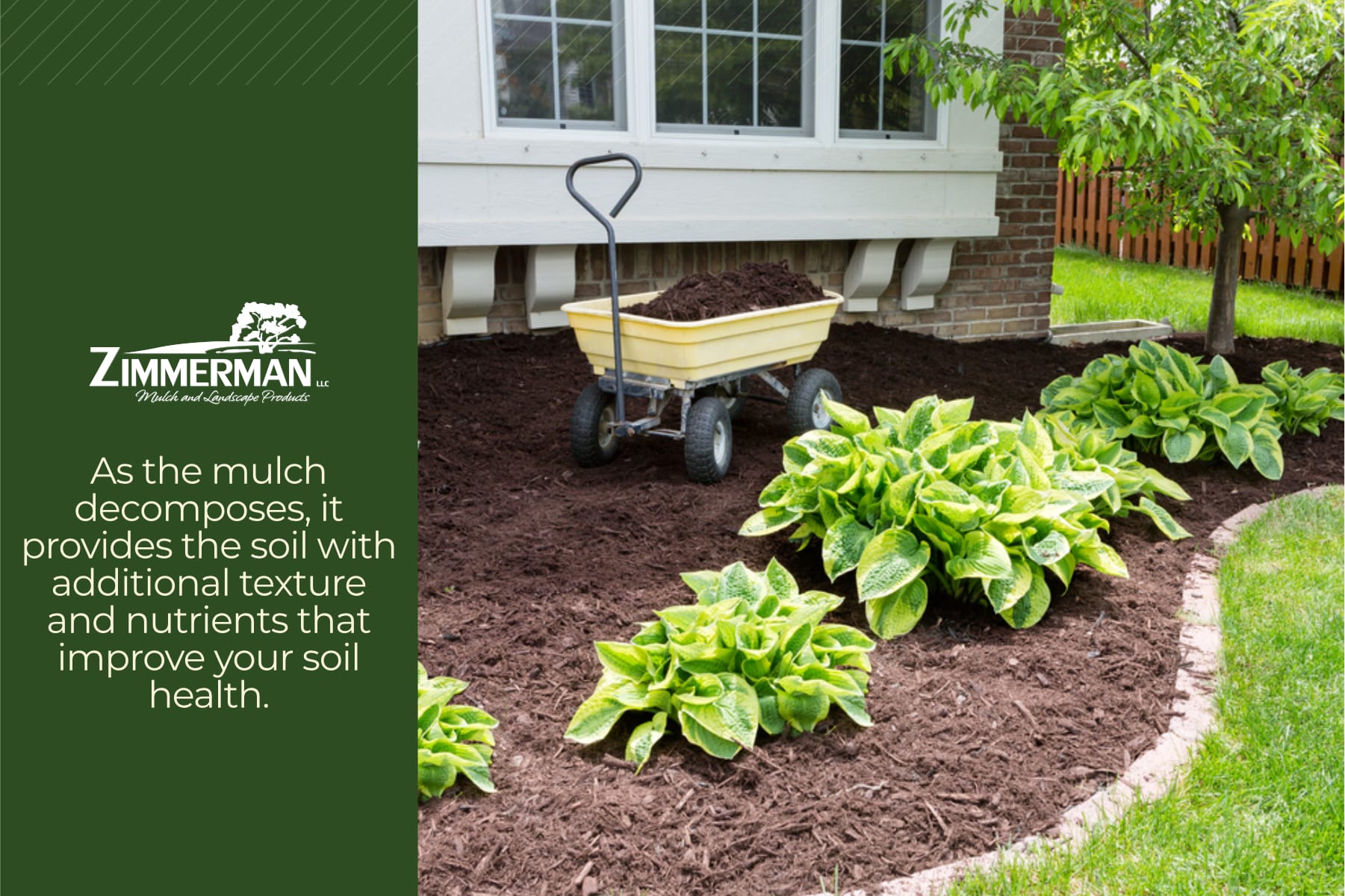
In turn, healthier soil improves the health of your plants.
-
Retains moisture
When you water your plants, some water inevitably evaporates and escapes from the soil. If you live in a hot, dry area, that can mean thirsty plants and constant watering.
Mulch acts as a barrier that helps prevent moisture from escaping as fast, saving it for your plants.
Remember that some kinds of mulch are better moisture retainers than others. Organic mulch retains moisture best, while inorganic types such as rubber chips or gravel do not hold water well.
-
Regulates soil temperature
If you did not have insulation in your home that kept the temperature constant, you would experience temperature fluctuations in your home, and you would not be very comfortable!
In the same way, plants are not comfortable and do not thrive when they experience extreme temperature changes in the soil. Mulch acts like the insulation in your house, preventing the ground temperature from fluctuating too much and keeping your plants comfortable and happy.
-
Helps prevent soil compaction and erosion
Over time, rain and wind can cause your soil to erode or compact into a solid lump over time.
Mild erosion or compaction is not always damaging; too much could hurt your plants. Mulch provides an extra layer of protection between your soil and the elements so the weather doesn’t wreak havoc on your soil health.
-
Improves aesthetics
Lastly, mulch makes your landscaping look amazing! There are few sights more satisfying than a freshly mulched landscape.
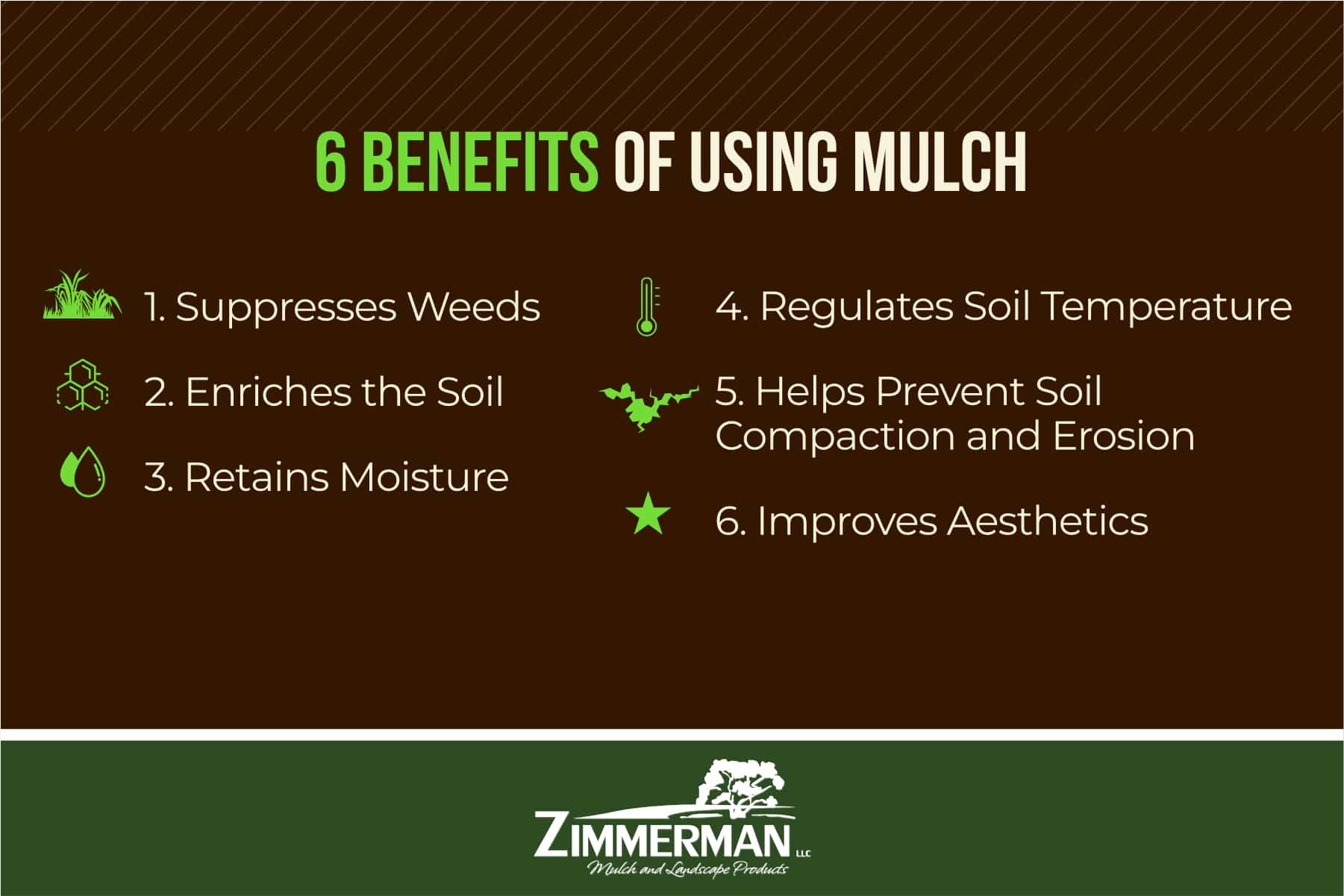
2. What is mulch made of?
When we ask this question, we must remember that many different mulch types exist! After all, you can define mulch as anything you spread over the ground's surface as a covering.
There are two main types of mulch: organic and inorganic.
Inorganic mulch can be gravel, rubber chips, plastic, or other inorganic materials.
Organic mulch is anything organic, such as grass clippings, pine needles, shredded leaves, straw or hay, or the typical bark mulch most people think of when they hear the word "mulch."
That stereotypical bark mulch, which probably popped into your mind when you heard "mulch," is made by shredding tree bark to create a finer mixture. Then the bark is aged for several months until it softens and starts decomposing–then it can be used as mulch.
Some bark mulches are color-dyed shades such as red, black, or chocolate, so you can choose a color that compliments your house and the rest of your landscaping.
The finer a mulch is shredded, the longer it is aged, and the more nutrients it adds to the soil. However, coarse, less-aged mulch lasts much longer and does not need to be replaced as often.
To learn more about mulch, read our blog on the different types of mulch.
3. How much mulch will I need?
Most stores sell their mulch by the cubic yard. One cubic yard of mulch covers 324 square feet at a depth of one inch.
Here is how to determine how much mulch you need:
- Calculate how many square feet you need to mulch.
- Take that number times the depth in inches you would like to apply your mulch.
- Divide the result by 324, and you have the cubic yards of mulch you need to buy to cover the desired area.
This is the formula you want: Square footage x desired depth / 324 square feet = total cubic yards required.
It’s probably best to calculate a little high or buy a few extra cubic yards of mulch to ensure you don’t run short.
You can also use an online mulch calculator like this one to make things easier.
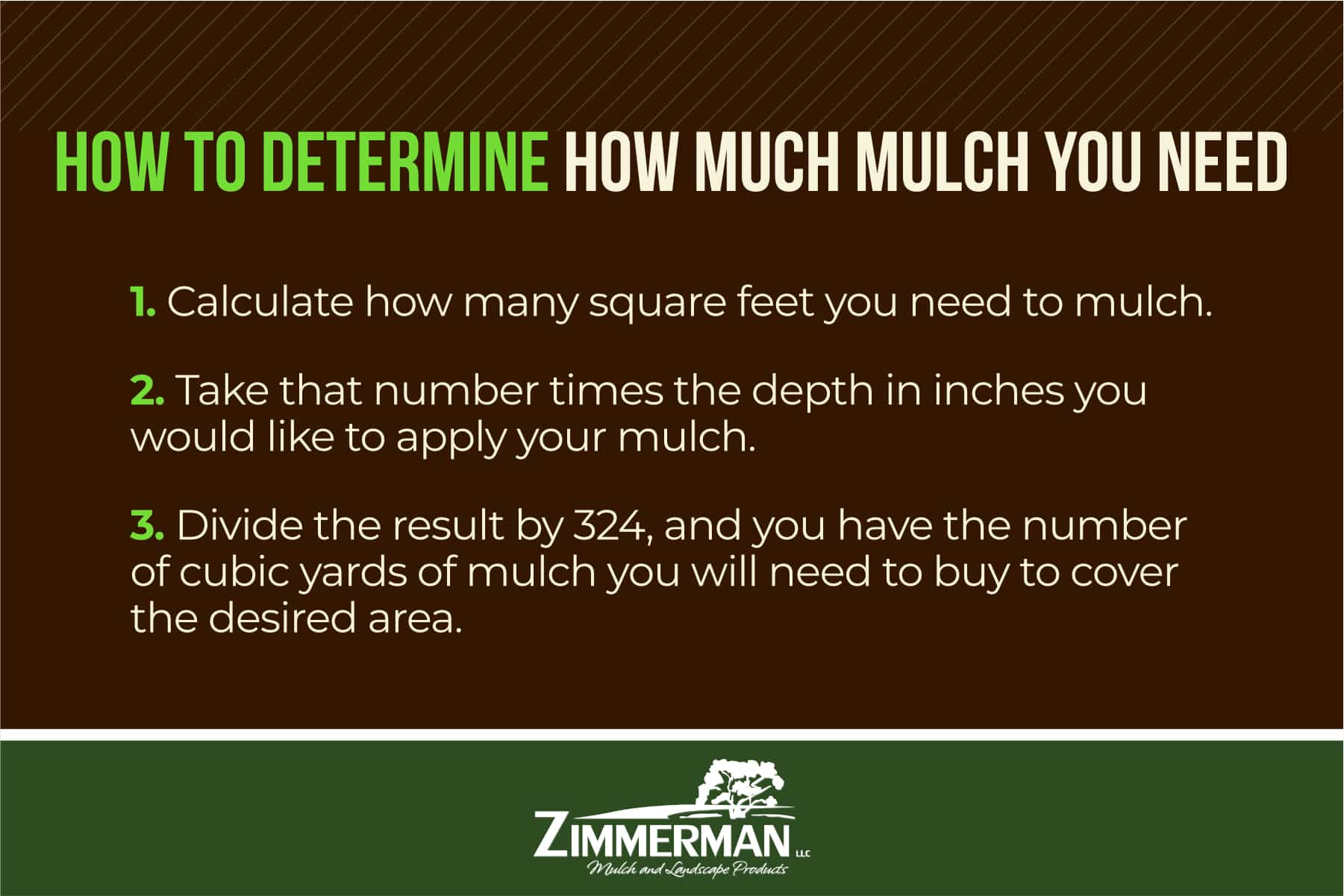
4. What is the best time of year to put down mulch?
Mid-to-late spring, just when the ground is warming up from winter freezes, is considered mulching season, although some gardeners prefer to mulch in the fall.
It is recommended not to mulch too soon in the spring because that could slow down the thawing process. Alternatively, it would be best if you didn’t mulch too late in the fall because that could prevent your plants from becoming dormant, which they need to do to protect themselves from winter temperatures.
One perk of mulching in the spring is enjoying your fresh mulch all summer while hosting outdoor events and picnics!
Some gardeners believe in winter mulching because it may provide some damage control for the parts of the plants that are above ground. However, if you mulch in winter, you won’t reap the full benefits of the beauty of your fresh mulch.
So to sum it up, the best way to use topsoil and compost is in combination. Topsoil provides the soil's base and bulk, and a little compost offers that extra boost of richness and nutrients.
5. What should you do before putting down mulch?
Before applying mulch to your flower beds, you must prepare them. Here are a few things we recommend doing before applying your mulch:
- First, remove all weeds from your flower beds. If you don’t, the mulch may help the weeds to grow better, as well as your plants!
- Trim any bushes or trees in the area. You don’t want to trim these after you mulch and scatter the debris all over your mulch layer.
- Clean up any debris in your flowerbeds, such as old sticks, leaves, and mulch from previous years.
- If you really want to stop the weeds in their tracks, apply a pre-emergent herbicide to prevent weed seeds from sprouting. It’s best to use herbicides before, not after, your mulch, as it will be easier for them to reach the weed seeds if they don’t have to pass through the mulch.
- Fluff or till your soil to aerate it. Then smooth the ground so your mulch layer doesn’t turn out lumpy.
- For the best visual effect, edge your flowerbed with a shovel or edger to create a clear boundary. Use your garden hose as a guide to get a smooth, flowing edge.
- If your soil is dry, water it before putting down your mulch. The mulch will seal in the moisture and keep it in the ground.
- If you like, lay down landscaping fabric or another weed barrier. Be sure to use a barrier that breathes and allows water to pass through. Never use plastic!
- Apply your mulch!
Pro Tip: Before your mulch is delivered, lay down a large tarp to dump it on. That way, you don’t have to deal with much cleanup in your yard.
6. What should I do after putting down mulch?
The work is not complete once you apply your mulch. To get the best results, you will need to maintain your mulch.
Here are a few things you can do to get the most out of your mulch:
- If your beds are dry, water your flowerbeds directly after you apply your mulch. Sprinkling on some water can help the mulch settle into an even layer while providing plant moisture.
- You shouldn’t have too many weed troubles after mulching, but keep an eye out and pull any hardy weeds directly before they get out of hand.
- If you want the healthiest flowerbeds, turn your mulch every several months. Turning and fluffing it improves air and water flow and helps it stay looking fresh since the top layer will naturally compact and wear down.
- Replace your mulch every year.
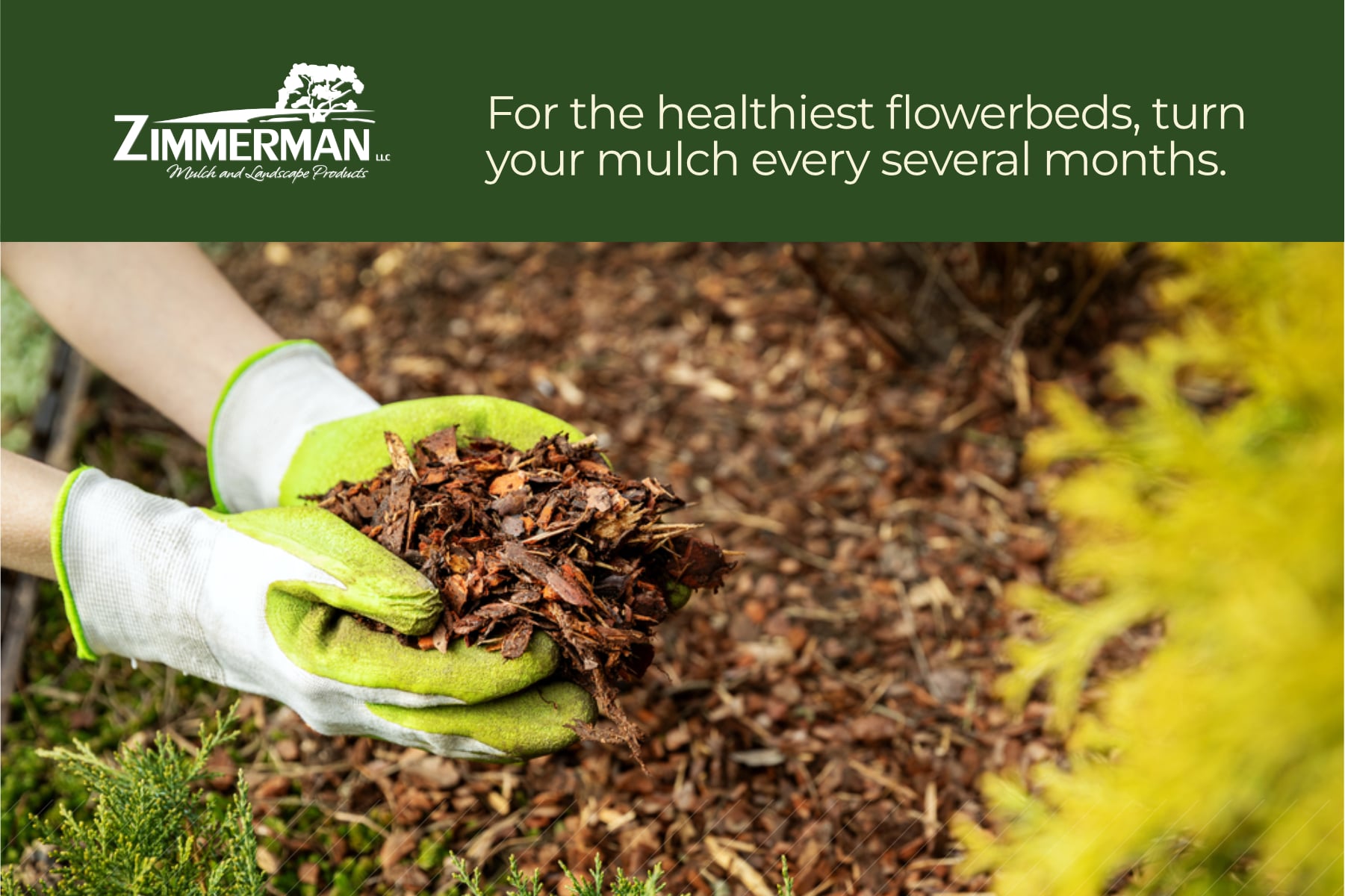
7. How deep should mulch be?
Most gardeners agree that the ideal depth for organic mulch is about 2-3 inches. That is deep enough to keep down weeds and insulate the soil but not so deep that the mulch smothers plants or prevents water from getting to the soil.
Finely shredded organic mulch should not be more than 3 inches deep. However, coarser mulches such as un-aged wood chips or pine bark nuggets allow for more air and water movement to be applied up to 4 inches thick.
8. How often should you replace mulch?
As we said, organic mulch breaks down over time, which is good for your soil but means you will have to replace your mulch regularly. Lighter mulch may wash or blow away, and color-dyed mulch may fade and turn grayish.
How often you need to replace your mulch depends on what type of mulch you have. Finely shredded and aged bark mulch will decompose faster than wood chips or coarser ones.
As a rule of thumb, you must replace or refresh organic mulch yearly. We recommend you check your mulch in the Spring and see how it looks. If it seems similar to how it did when you applied it, you probably don’t need to replace it entirely. Simply turning and fluffing it a little should do the trick.
However, if it looks gray, worn out, and compacted, or if there isn’t much mulch left, you should probably replace it with a fresh layer.
For organic mulches or mulches with a tougher composition, you may be able to leave them for several years before replacing them.
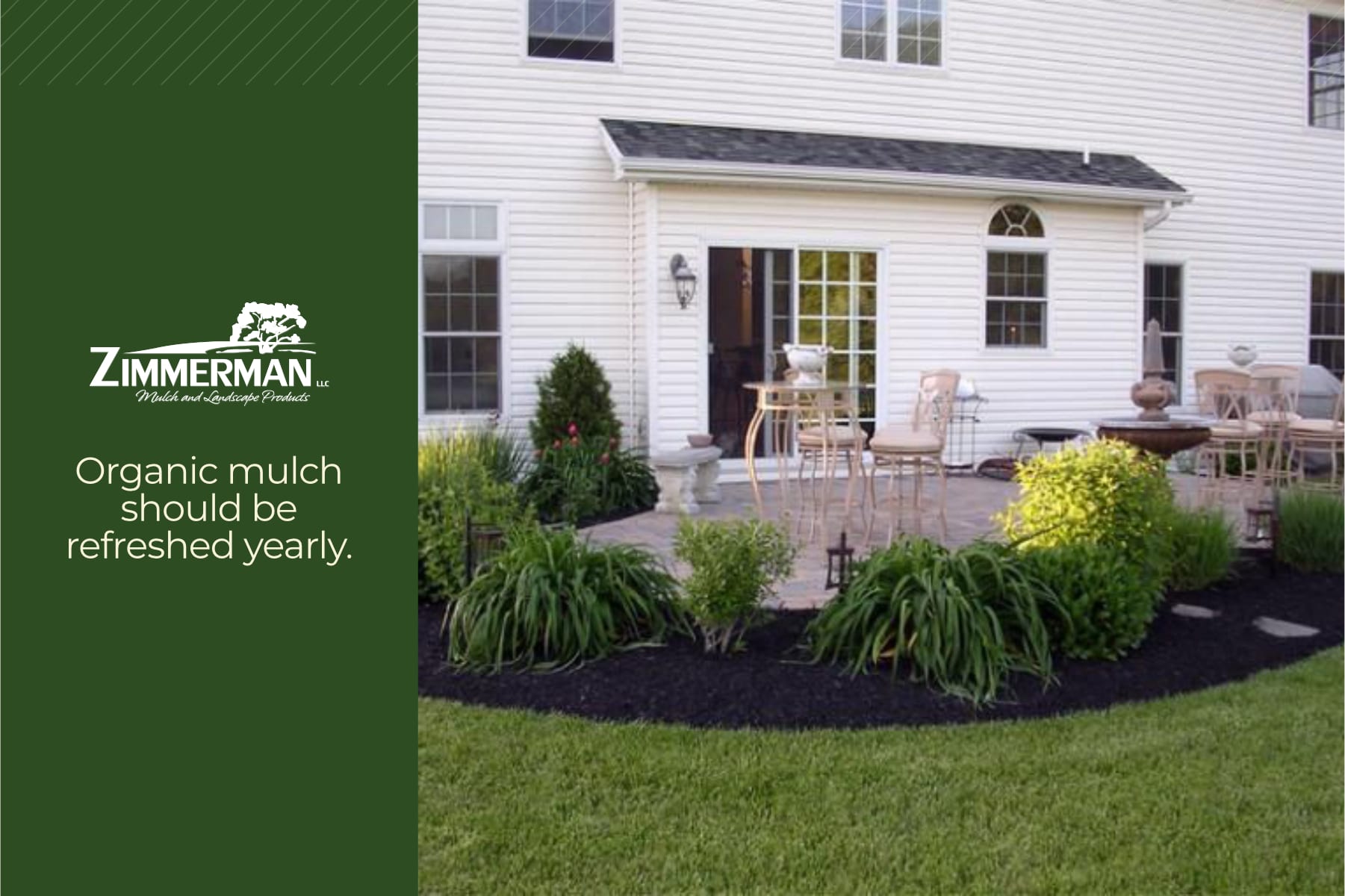
9. Will mulch attract bugs?
Most often, it is not the mulch that attracts pests but the conditions it offers.
Here are a few examples of ways mulch attracts critters:
- Mosquitoes seek wet places to lay their eggs, which they can find in oversaturated mulch.
- Spiders like wood dust and moist places–like mulch beds. They are also attracted to the other insects that may live in your garden, which are their food source.
- Cockroaches are attracted to decomposing materials and may be attracted to certain types of organic mulch.
- Mice and voles may think your mulch is a reasonably warm, safe, and inviting place to hole up.
- Ants, especially carpenter ants, love wood, especially decaying wood, so that they may be attracted to mulch.
- Termites love the moist, cool protection mulch provides, as well as the wood, which is their food source.
The good news is that some of these critters, such as spiders, may actually help your plants by eating other pesky insects. But some you would probably rather avoid!
Thankfully, you can avoid most of these critters by applying your mulch correctly. Here is how to ensure your mulch doesn’t become a haven for pests.
- Do not apply your mulch too thick. Keep it around 2-3 inches so it drains and doesn’t become oversaturated. Most pests love moist, wet places.
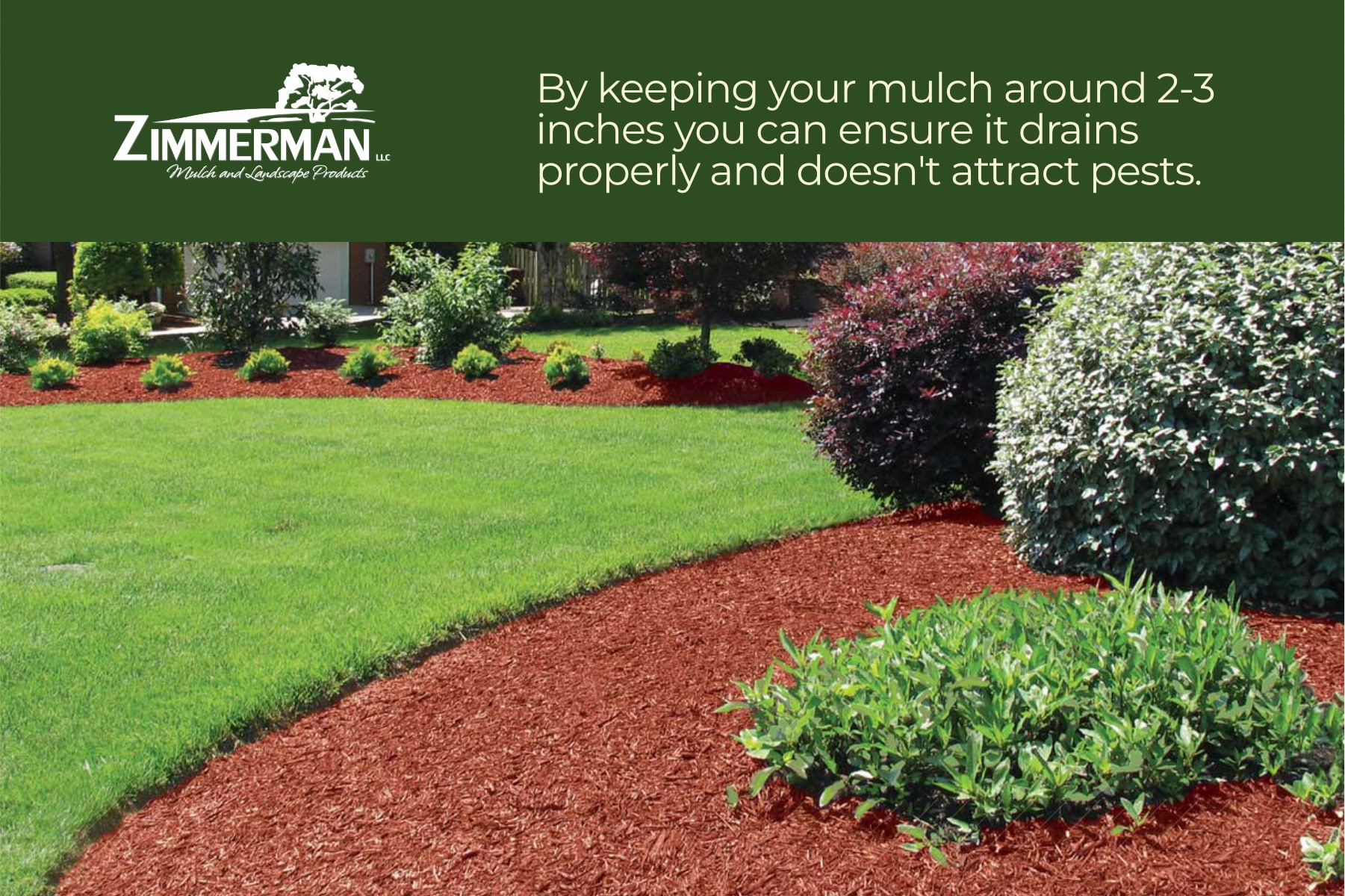
- If you think pests may be an issue on your property, use cedar or cypress mulch. These woods have natural chemicals and oils in them that deter pests.
- Use inorganic mulch such as rubber chips or gravel.
- Never pile mulch up directly next to your house. Leave several inches of space between your mulch and your home so the area next to your walls doesn’t become a pest haven.
- Be sure to leave a buffer zone between your plants and your home. Plants can act as a bridge for pests to enter your house.
If you apply your mulch correctly, you shouldn’t have too much trouble with pesky critters!
10. What color of mulch is best?
There are three primary mulch colors, which are best will depend on your situation.
Here are the three types:
- Red mulch
Red mulch is dyed a rusty red color and looks good with lighter-colored plants or flowers with warm yellow, red, or orange hues. It doesn’t tend to complement brick houses because the red of the brick is too close in hue to the red of the mulch.
Be careful when using red mulch, as the red dye can sometimes stain concrete and stone.
- Brown mulch
Brown mulch is an excellent neutral choice. It complements dark and light-colored plants and looks nice and natural for those who prefer a more subdued look.
Brown mulch tends to complement brick houses excellently. It also doesn’t tend to fade as quickly as some colors.
- Black mulch
Black mulch is sharp, snappy, and looks good with modern or contemporary homes. It complements dark-colored plants such as dark, leafy ivy.
One downside to black mulch is that it heats up faster than other colors, so if you live in a hot climate, it may cause your plants to overheat.
Which mulch color you should go with depends on your tastes and your current home and landscaping–so there isn’t technically the best color to choose.
CONCLUSION
We hope this article helped answer some of your questions about mulch and mulching!
We wish you good luck with your landscaping.
If you want to pick up some mulch today, check out the different types at Zimmerman Mulch. We offer various types of mulch as well as delivery services.
We also offer other outdoor living products, such as:
- Topsoil and compost
- Gravel and stone
- Hardscape materials
- Natural stone
- Lawn and garden
- Landscape lighting
- Outdoor living
And more! Check it all out today at the Zimmerman Mulch website.
We look forward to hearing from you!